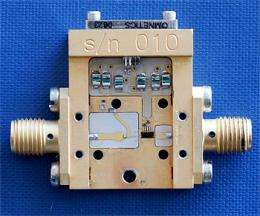Researchers at Chalmers have developed a new generation of amplifiers, which the European Space Agency (ESA) will be using throughout the world to receive signals from its space probes and satellites. ESA will be able to use the new amplifiers to measure data that is currently buried by noise.
The research group has developed and built 30 ultrasensitive, cryogenically cooled amplifiers for receiving satellite signals. They will be used, for example, in the receiver of the Cebreros tracking station, which will be upgraded within a few weeks. Cebreros provides daily information on the space projects Venus Express, Mars Express and Rosetta.
ESA's satellites investigate and monitor atmospheric changes on the Earth, for example. Their space probes collect data on the solar system, the planets as well as comets. The signals from satellites and space probes are received by antennas installed in various places around the surface of the Earth so that signals can be received regardless of the Earth's rotation. The amplifier is one of the most important building blocks of these antennas and determines the quality of the entire receiver chain.
The new amplifiers from Chalmers have several advantages over their predecessors. Their primary benefit is that they add less noise to the satellite signal, which enables major possibilities for space research.
"Communication is more reliable," says Piotr Starski, one of the Chalmers' researchers who have developed the amplifiers. "Satellite availability will also be improved since it will be possible to follow them farther down toward the horizon where atmospheric noise contribution increases."
The additional noise in the amplifiers is referred to as the noise temperature, NT, and is measured in Kelvin (K). The new amplifiers have a noise temperature of just 4 K.
"This is exceptionally good for this type of circuit, nearly state-of-the-art," says Piotr Starski. "We have also had a more modern approach to the design which has enabled us to make much smaller and less expensive amplifiers than their predecessors."
The amplifiers are built with so called Monolithic Microwave Integrated Circuits (MMIC), which means that they are complete components that are much easier to assemble. Previously it was not possible to build cooled MMIC amplifiers that performed adequately. But researchers at Chalmers have achieved performance that is as good as that of hybrid amplifiers, which are much more expensive and complicated to produce.
Production of the amplifiers has been done in collaboration with Low Noise Factory, a start-up company from Chalmers. The reason that ESA ordered the amplifiers from Chalmers is that the Microwave Electronic Laboratory at Chalmers is one of a very few places in the world that is capable of developing cryogenically cooled amplifiers with extremely low noise and adequate performance, especially as MMIC.
Provided by Chalmers University of Technology























